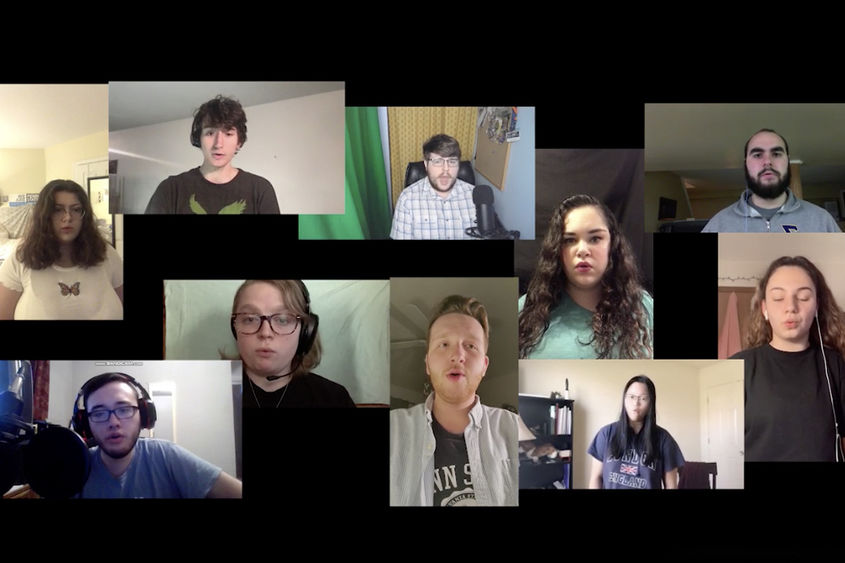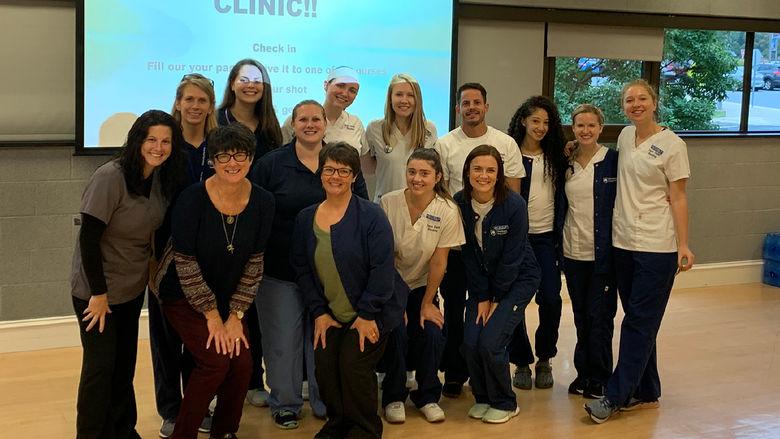
Two vocal ensembles at Penn State Harrisburg had to get creative to prepare for a spring concert that would now be held virtually. Some 35 singers from both ensembles used rehearsal tracks created using Finale, a digital notation program.
MIDDLETOWN, Pa. -- For several Fridays since Penn State moved to all remote teaching, learning and working during the novel coronavirus pandemic, Penn State Harrisburg faculty have put on their best Zoom virtual backgrounds and joined their peers for “Virtual Social Distancing Happy Hours.” Hosted by the college’s Faculty Senate, these events are giving faculty a chance to share their experiences – the challenges, triumphs and innovations – as they are adapting lesson plans and teaching processes during this time of social distancing.
“Virtual Social Distancing Happy Hours have enabled us to establish a faculty-led community of practice that we all benefited from, both personally and professionally,” said immediate past president of the college’s Faculty Senate Roderick Lee, associate professor of information systems.
New technologies, new tools
While many faculty members are already familiar with Zoom, many of them had to learn new technologies to supplement their lessons.
Raquel Lodeiro, lecturer in Spanish, is using platforms such as Canvas, VoiceThread (a cloud-based technology where users post video, audio, or text content in a threaded conversation), and Zoom to recreate her learning experiences in a virtual context.
She had a head start on virtual learning as she already was planning a hybrid Spanish class for summer 2020. William Illingworth, an instructional designer in the college’s Center for Teaching Excellence who is assisting Lodeiro, noted that she had never taught online before.
“It’s thrilling to see her upbeat spirit not only survive but thrive in this time of changes," Illingworth said.
Lodeiro said using new tools helps her online instruction resemble what she does in class, adding that students appreciate actually seeing her during the online lectures. “The students realized how nice it is to see each other," she said. "I taught about the topic of family so I shared pictures of my family to practice the vocabulary.”
Recently, she was able to conduct a class with students in Harrisburg, Pennsylvania and Taiwan by having the students share photographs and comment upon them in Spanish using VoiceThread.
“We are a team and we will get through this together.”
-One of Professor of Environmental Engineering Shirley Clark's students, on the transition to remote learning
Instructor Kelsey Kirk, lecturer in information technology, admitted that she was anxious about how she would be able to conduct class in a remote environment. The distributed computing/business programming course she teaches is a technical, hands-on computer programming course.
“While we have faced some technical challenges, I am pleased to report that it is going much better than I had expected,” she said.
Kirk said that she has used the screen sharing function in Zoom to continue the collaborative nature of the course.
“This has not only allowed me to continue to engage with students by helping them to resolve their issues, but has also allowed other students to observe how I approach troubleshooting,” Kirk added. “Instead of just watching me troubleshoot, I was impressed to see that everyone in the class was contributing suggestions, possible solutions, and identifying errors. My students enhanced their problem-solving skills, and taught me to be flexible in my expectations and to make the most out of these new online learning environment experiences.”
The move to remote learning meant that Adam Gustafson, associate teaching professor of music, had to get creative to prepare his choir students for a spring concert that would now be held virtually.
The two vocal ensembles he instructs created a “virtual choir” utilizing the repertoire they had been slated to perform. Roughly 35 singers from both ensembles used rehearsal tracks created using Finale, a digital notation program. Using headphones, they sang with the tracks and recorded themselves. Gustafson then took those files and rendered them into one sound file using Reaper, a digital audio workstation. Their videos were combined and rendered using Adobe Premiere Pro.
Catherine McCormick, assistant teaching professor of communications and humanities, typically uses hands-on instruction in her photography course, as students practice working in Adobe Photoshop to edit and alter photos. Now, during Zoom sessions, she utilizes the share screen function to instruct the entire class, and then she assigns each student to an individual breakout room where she joins them individually to provide one-on-one instruction and answer questions.
McCormick also collaborated with Heidi Abbey-Moyer, associate librarian and coordinator of the college’s Archives and Special Collections, to test a virtual visit to Archives and Special Collections. Using Flickr, an online photo sharing platform, library staff was able to translate a traditionally hands-on archives workshop into an online learning experience.
Melanie Gardner, lecturer in speech communications, took her mass media and society class on a virtual tour of a radio station cluster where they were able to see a variety of studios including a large 3-room talk radio studio, 3 different music studios, a radio newsroom, production facilities, and more.
“I showed the students how the studios function from playing music to taking and editing listener calls,” Gardner said. “The students were able to interact with DJs on air at the time, as well as the chief radio engineer.”
Engagement and participation
Faculty members said they are finding an increase in class participation and engagement in their virtual classes.
Kirk found a concept she is using in her virtual lessons to be so successful that she is considering how she can incorporate it into her in-person classes.
“In class I used Zoom Polls to facilitate an exam review. I wanted to use the exam review as a way for the students to gauge their strengths and weaknesses," Kirk said. "I made the responses anonymous so that everyone could respond in a judgement-free environment. While it was a tedious process to set up the polls, it was a worthwhile effort, because I had excellent participation in the review session, over 80 percent of all attendees.”
She added that generally, during the in-person exam review sessions, she has a few students who will always engage and participate and she thought it would be more difficult to observe in this remote environment. “While I was expecting a similar experience to what we have had in-class, I was surprised to see that I was able to maximize class participation using the Zoom polls,” she said.
Maintaining a sense of community
Overall, faculty has been sensitive to the challenges students might be facing with the move to remote learning.
In an email to her students when the University first began virtual learning, Shirley Clark, professor of environmental engineering, acknowledged this and encouraged students to talk about it. As a follow up, she created a related discussion thread in Canvas. She added that her students were encouraged, with one replying: “We are a team and we will get through this together.”
In virtual sessions, she tries to make students feel more relaxed and comfortable by periodically featuring her pet cat during Zoom sessions. She added that this has been particularly helpful for one of her students who is now providing care for her pre-school/young elementary cousins.
Cobi Michael, associate teaching professor of psychology, is making an effort to accommodate students who may be struggling or who hold essential jobs and must work outside the home.
“I told my students that if they are in a different time zone or experiencing other difficulties with synchronous delivery that they can email me, and I will add them to a list of students who are allowed to watch the video meetings without attending them live," Michael said. "I do not want to add to anyone's struggles right now. I offer this option to anyone, including those in essential jobs right now, who are experiencing unimaginable stress.”
"We Are" stories
The “We Are” spirit is perhaps more important than ever before, and Penn Staters everywhere are coming together in new and amazing ways. During these challenging times, our community is continuing to realize Penn State’s commitment to excellence through acts of collaboration, thoughtfulness and kindness. As President Eric Barron has written on Digging Deeper, this truly is a “We Are” moment — and we want to hear your “We Are” stories.
Visit news.psu.edu/WeAre to share how you or other Penn Staters are supporting each other to overcome the collective challenges presented by novel coronavirus. We are!






